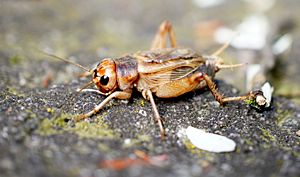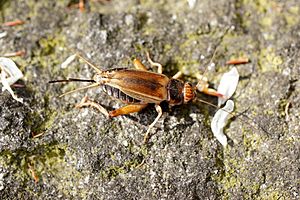Jamaican field cricket facts for kids
Quick facts for kids Jamaican field cricket |
|
|---|---|
 |
|
| Gryllus assimilis male | |
| Scientific classification | |
| Genus: |
Gryllus
|
| Species: |
assimilis
|
| Synonyms | |
|
|
Gryllus assimilis, also known as the Jamaican field cricket, is a type of field cricket. You might sometimes hear it called the "silent cricket," but that's not quite right because the males do make sounds! These crickets naturally live in the West Indies, parts of the southern United States, Mexico, and South America. Since about 2010, they have become very popular as food for pet reptiles and other animals. Because of this, you can now find them for sale all over North America and Europe.
Contents
Discovering Cricket Species
For a long time, scientists thought many field crickets in the eastern United States were all the same species, called Gryllus assimilis. But in 1932, a scientist named B. B. Fulton made an interesting discovery. He found four groups of crickets in North Carolina that looked exactly alike. Even though they looked the same, they each sang different songs!
Scientists also noticed that these groups had different life cycles during the year. They could not breed with each other, even if they lived in the same areas. This led to the idea that there were actually eight different cricket species in the eastern states. Some of these species had songs that sounded the same but were active at different times of the year. One type of male cricket was even completely silent!
Once scientists could tell these species apart by their songs, they found tiny differences in how they looked. For example, they noticed small variations in the number of "teeth" on the part of their body they use to make sound. The true Jamaican field cricket was first described in 1775 by a Danish zoologist named Johan Christian Fabricius. Its original home, or "type locality," was Jamaica.
Cricket Subspecies
There are two main types, or subspecies, of the Jamaican field cricket:
- G. a. assimilis (Fabricius, 1775) - Found in the West Indies, United States, Mexico, and South America.
- G. a. pallida Saussure, 1897 - Found in Mexico.
Where Jamaican Field Crickets Live
The Jamaican field cricket lives in the West Indies, the southern parts of the United States, Mexico, and some areas of South America. In the United States, you can find them in Florida and southern Texas. They like to live in places with lots of plants, like weedy fields, roadsides, lawns, and grassy pastures.
Jamaican Field Cricket Life Cycle
Female crickets can lay up to 400 eggs. They use a special tube called an ovipositor to place their eggs into damp soil. If the temperature is warm enough, between 25°C (77°F) and 30°C (86°F), the eggs usually hatch in about eleven days.
After hatching, the young crickets, called nymphs, grow for about three to seven weeks. During this time, they shed their skin several times as they get bigger. Once they are fully grown, the males start singing to attract females. Sometimes, adult crickets looking for food in the soil might accidentally eat some of the eggs.
Crickets as Garden Pests
These crickets can sometimes be a problem in vegetable and flower gardens. They can also cause trouble in places where citrus trees are grown. In the past, people used different methods to control them.
The Cricket's Call
Only male Jamaican field crickets make a call. Their song is a short, quick chirp that they repeat about once every second. The sound is made up of many fast pulses, so each chirp sounds like one continuous noise. This call helps them attract female crickets.
Cricket Diseases and Their Importance
The Jamaican field cricket is special because it is not affected by the cricket paralysis virus. This virus caused a big problem in 2010 for companies that raise crickets. It badly affected the common house crickets sold in the United States and Europe.
Because the Jamaican field cricket is immune to this virus, it has become the new "standard" cricket. Now, it is widely available for people to buy as food for their pet reptiles, spiders, and other animals.
Confusing Crickets: Gryllus locorojo and Gryllus assimilis
There is another cricket species called Gryllus locorojo, which is sometimes confused with Gryllus assimilis. Gryllus locorojo is also known as the "crazy red" or "banana cricket." It looks a bit different and sings different songs.
Gryllus locorojo is a medium-sized cricket. It can have long or short wings. Its head is usually reddish or brownish with three or four stripes. This cricket was often called Gryllus assimilis in Russia and Europe. However, scientists D.B. Weissman and D.A. Gray described it as a new species in 2012. So, it's important not to confuse it with the true Jamaican field cricket.


